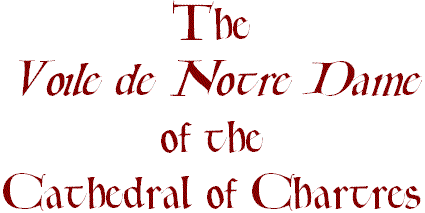

| Some kind of relic of the
Virgin--variously called a "tunic" or a "shirt" (Latin "tunica" or "camisa"/French chemise) was in the possession of the Cathedral chapter of Chartres from the time of Emperor Charles the Bald, who was said to have received it himself from the Pope and given it to the cathedral. |
| The learned Canon of the Cathedral Yves Delaporte wrote a concise summary (in French, with our own rough-n-ready Englishing) of the history of the pilgrimage connected with this relic for the Dictionnaire d'Histoire et Géographie Ecclesiastique (1952). |
|
Here are a few 1927 postcard images (with their captions) of the "Voile de Notre-Dame," at that time apparently on display in the lower (ground) floor of the chapel of St. Piat, East of the apse of the cathedral: |
(24 mars 1927)"(Part of the beautifully carved sarcophagus of John of Salisbury, Bishop of Chartres
[† 1180], excavated from the abbey of St. Mary "Josaphat" at Lèves (2km downstream on the Eure from Chartres) in 1905-6, is visible in the lower left; the sarcophagus was later returned to its place in the transept of the ruins of the abbey church, where it may be seen today.)
"Detail du tissue oriental servant d'envelope à la relique (grandeure reélle [i.e., the size of a modern postcard])."
[The "voile" was apparently preserved in an "envelope" of cloth which was decorated with this design.]
The Relic Today
Thanks to Professor Dawn Marie Hayes of Iona College,
here is what the "Voile" looks like today in its 19th century
monstrance reliquary in the Chapel of St. Piat,
off the East end of the Cathedral: The Voile Today
(here's a link to a local copy if this one's no longer there).
2193435